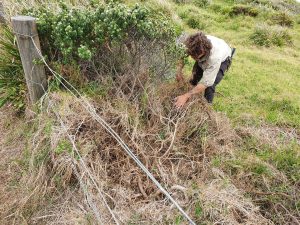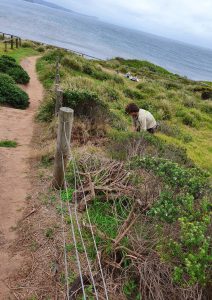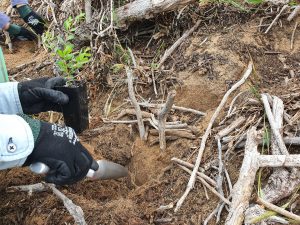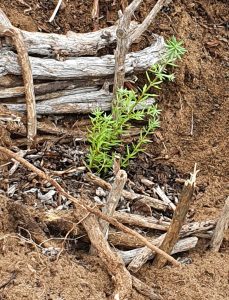The BOM (Bureau of Meteorology) predicted rain – but thankfully, they were wrong as usual. The Saturday was a cloudy day with quite a bit of wind which made it fun trying to put weeds in the weed bags! But a perfect temperature for working on our site. We had 60 plants to put in on the western side of the site which is very steep, and therefore involves some landscaping, in places – with almost building terraces for our plants so that they are stabilised in the cliff after planting and that rain water will move into their trough which we create in the appropriate space on site.
Half the group worked on one area on the southern western side some worked in the gully area where we planted the five Goodenia dimorpha as it’s a bit sheltered there, the other plants were planted on the western side where they planted some coastal tea tree, Hibbertia scandens, native rosemary, banksia, Melaluca Amillirs.

Six of us on the southern western side unfortunately had to spend the first hour removing the non-native pig’s face which had grown down the slope to the proposed planting area – a few months ago, this area was clear, but the non-native
pigs face is a very aggressive grower having engulfed previously planted plants from last month; unfortunately none of the Isolepis nodosa plantings survived being covered by the pigs face. The past amount of rain we have had, the non- native pigs face has literally exploded, it’s now becoming a problem as big as the Bitou. Such ashame as Peter Miller spent so much time ensuring we only had the native pigs face on site… alas, it was not so….
After Morning tea the six who had worked on the steep slope then worked on the eastern flat removing th e Bromus grass which has come onto our site as it has moved down the public path way which is Council responsibility – we did ask last year if Council could get contractors in to remove, but this did not happen. We have asked again this year.
e Bromus grass which has come onto our site as it has moved down the public path way which is Council responsibility – we did ask last year if Council could get contractors in to remove, but this did not happen. We have asked again this year.
Reefcare advised Council of this weed issue 3 years ago.
Our wonderful supervisor spent the latter morning continuing to remove the kikuyu from along the track fence line and off the native plants – it’s really looking good along there now thanks to Jarrah – as you can see from the photos.
The bulk of other team members moved back up to the western slope to finish with the plantings, removing bitou and weeding as they headed west, whilst two members – Merrilyn and Gen, went around the site targeting a Gladiolus which appeared about three years ago. Georgia Williams from Council advises that is it “most likely a hybrid but similar to Gladiolus caryophyllaceous”. This does need to be targeted because if left will spread over bushland and impact plant communities – given the number of seeds around the corm and also the amount seeds in the pod after flowering, I can certainly see how a few of these could quite quickly become more than many – what an amazing set up for over propagation.




